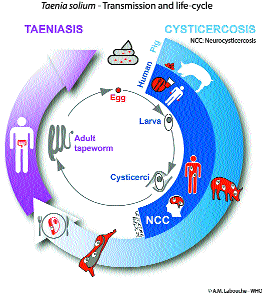Cysticercosis of brain is common cause of epilepsy: Dr Garcia
| Date :25-Jul-2020 |

Infection of the human brain by cystic larvae of the pork tapeworm species Taenia solium is the most frequent cause of epilepsy in developing countries in the world, said Dr Hector Garcia, expert on Neurocysticercosis from Peru, during his talk in WFN - FINE neuroinfection webinar organised by Tropical and Geographical Neurology specialty group of World Federation of Neurology (WFN) in collaboration with Forum for Indian Neurology education. It is responsible for 30 % cases of Epilepsy in areas endemic for cysticercosis. It is most commonly found in Latin America, South East Asia and Africa and is most prevalent in rural areas where pigs are allowed to roam freely.
Transmission takes place through a pig-human cycle in which humans harbor the adult intestinal tapeworm (taeniasis) and pigs carry the cystic larvae in their flesh (cysticercosis). Lack of sanitation and open air defecation, allow pigs to become infected by consuming human feces containing tapeworm eggs. In turn, humans acquire taeniasis by consuming pork contaminated with larval cysts or acquire neurocysticercosis through incidental ingestion of tapeworm eggs.
Dr Garcia mentioned, there are multiple and diverse presentation of neurocysticercosis in form of single cyst, multiple cysts, cysticercous granuloma, calcified lesions and cysts at the base of the brain and also in spinal cord. Cysts are even seen in eyes. Ingestion of tapework eggs in human is due to fecal oral route or by drinking contaminated water and eating of contaminated raw vegetables.
Every year, 50 lakh people in the world develop this infection and 50 thousand people die due to it. Because of community intervention projects over last few years the number of cases of cysticercosis have reduced in Latin America. In Peru, Brazil, India and Honduras prevention of cysticercosis projects are going on. Number of active epilepsy cases associated with Neurocysticercosis are more than 10 lakh in India. It is more prevalent in Punjab, Uttar Pradesh, Bihar and Odisha. In Pork eating states like Punjab, there are more cases with multiple cysts and generalised cysticercosis.
Cysticercosis of Brain is preventable cause of Epilepsy. Cysticercosis is more observed in regions where pigs population is high. As Pigs are responsible for transmission of Cyticercosis, it is important to control the infestation in pigs, says Dr Chandrashekhar Meshram, President, Tropical Neurology group of World Federation of Neurology.
For the first time in the World, Vaccine for cysticercosis has been developed in India, in collaboration with other international agencies. It is for use since November 2016. Pigs should be vaccinated. Strategies for elimination will require treatment for humans and pigs, routine vaccination of pigs, better management of pig forms and pork production practices, improved sanitation and community health education. Construction of Toilets in all villages and educating people against open defecation will significantly bring down the incidence of Cysticercosis.
Dr Chandrashekhar Meshram, course director of the series welcomed the faculty and audience and explained the idea behind the series. Dr Raad Shakir former President of World federation of Neurology inaugurated the event and told the history of Tropical Neurology group and congratulated the group for organizing such an important event. Dr Wolfgang Grisold, Secretary General of WFN also addressed during the occasion. The series will be held every Saturday evening .
Second Session today
In the second session Dr Erich Schmutzhard from Austria will give a talk on Cerebral Malaria. Dr Gustavo Roman from USA and Dr Deanna Saylor from Zambia will chair the session. Dr Dhanpat Kumar Kochar, chief coordinator for malaria elimination research alliance, ICMR. Dr Mashina Chomba, Dr Sudhir Kothari and Dr Rahul Kulkarni will present interesting cases.